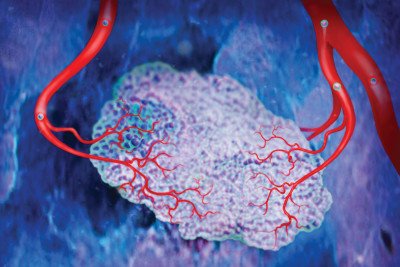
Angiogenesis is the process by which new blood vessels form, allowing the delivery of oxygen and nutrients to the body’s tissues. It is a vital function, required for growth and development as well as the healing of wounds.
But it also plays an important role in the formation of cancer because, like any other body part, tumors need a blood supply to thrive and grow.
In the early 1970s, the late investigator Judah Folkman first reported research showing that the formation of cancer depends on angiogenesis. Since then, many antiangiogenic compounds have been developed to stop cancers from growing or progressing — the idea being that choking off the blood supply would starve the tumor.
Today there are about a dozen antiangiogenic cancer drugs that have been approved by the US Food and Drug Administration, such as bevacizumab (Avastin®), which is used in the treatment of glioblastoma brain tumors and kidney, lung, and colorectal cancers. There are other antiangiogenic drugs in use as well, including several for treating kidney cancer. In addition, there are many experimental angiogenesis inhibitors in clinical development.
Some of these drugs have been shown to extend the lives of patients with advanced cancer, but overall they have not lived up to their early promise. We spoke with Memorial Sloan Kettering cancer biologist Robert Benezra about why this is the case.
Focus on the Tumor’s Environment
“One of the main questions in the field right now is, ‘Why aren’t angiogenesis inhibitors working like we expected them to?’” Dr. Benezra says. “In the clinic, they have shown some benefit in combination with chemotherapy, but the effect is not nearly as dramatic as people had hoped. Now we’re starting to get some ideas about why that might be.”
He explains that one reason for this might be “factors in the tissues surrounding the tumor that are conspiring against the effectiveness of antiangiogenic drugs.” These tissues — made up of immune cells, signaling molecules, and connective tissue, among other things — are collectively known as the tumor microenvironment.
Most of the angiogenesis inhibitors currently in clinical use target a protein called VEGF (pronounced veg-EFF). VEGF is a signaling molecule sent out by tumors to recruit the cells that form blood vessels.
According to Dr. Benezra, many experts now believe there are certain kinds of white blood cells in the tumor microenvironment producing a factor that allows tumors to bypass the need for VEGF in their formation of new blood vessels.
“Another idea is that the extracellular matrix, basically the glue that holds cells to the tissues, is somehow blocking the access of antiangiogenic drugs,” he adds. “One area of research is to use other compounds to modulate the extracellular matrix and make it more permeable to anti-VEGF therapy.”
Searching for Other Targets
Dr. Benezra and his team, as well as many other investigators, are looking for molecules other than VEGF that could be targeted to block angiogenesis. He explains that VEGF is used not only by tumors to recruit blood vessels, but by healthy tissue as well.
“Some of the side effects seen in patients treated with antiangiogenics happen because these drugs are also targeting normal blood vessels,” he says. These side effects can include high blood pressure and problems with bleeding and wound healing.
“There are other molecules that are more specific to tumor blood vessels, and I think these are better targets,” he adds.
He and his colleagues have identified a class of proteins called Id that are expressed in early precursor cells to tumor blood vessels but not in normal blood vessels. He is currently consulting with a small biotechnology company that is starting to evaluate these Id inhibitors in mice, not only for cancer but also for macular degeneration, an eye disease characterized by the overgrowth of blood vessels, which can lead to blindness.


